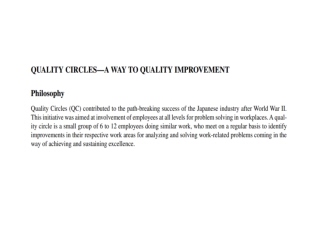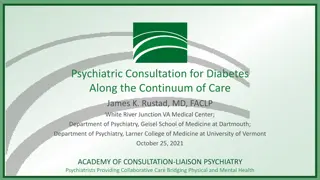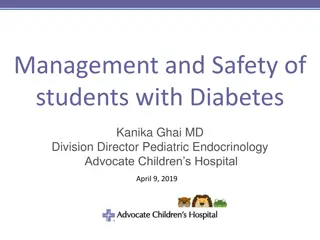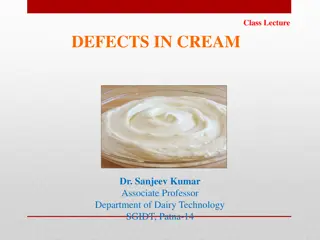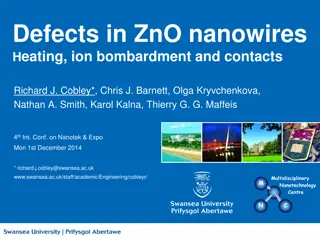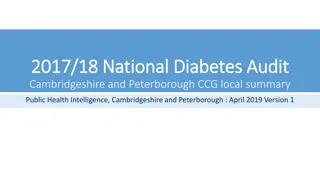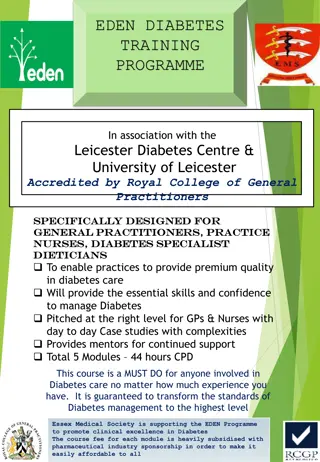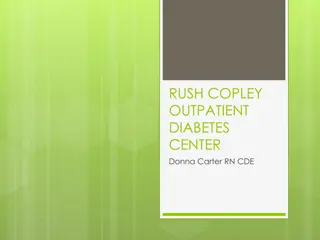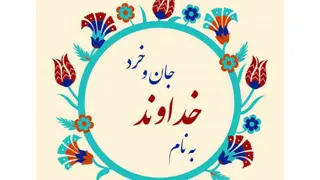Classification and Genetic Defects of Diabetes
The diagnosis and differential diagnosis of Type 1 and Type 2 diabetes are discussed, detailing the clinical courses, age of onset, body weight characteristics, onset patterns, and genetic factors. The etiologic classification of diabetes including insulin-deficient, immune-mediated, monogenic, and polygenic types is explained along with genetic defects in beta-cell function across different chromosomes. This comprehensive overview provides insights into the various aspects of diabetes classification and genetic mechanisms involved.
Download Presentation

Please find below an Image/Link to download the presentation.
The content on the website is provided AS IS for your information and personal use only. It may not be sold, licensed, or shared on other websites without obtaining consent from the author.If you encounter any issues during the download, it is possible that the publisher has removed the file from their server.
You are allowed to download the files provided on this website for personal or commercial use, subject to the condition that they are used lawfully. All files are the property of their respective owners.
The content on the website is provided AS IS for your information and personal use only. It may not be sold, licensed, or shared on other websites without obtaining consent from the author.
E N D
Presentation Transcript
Diagnosis of Type 1 Diabetes 1
Differential Diagnosis of Type 1 and Type 2 Diabetes Type 1 Diabetes Type 2 Diabetes Usual clinical course Insulin-dependent Initially non-insulin-dependent Usual age of onset <20 years (but ~50% over 20 years) >40 years but increasingly earlier Body weight Often lean but ~50% overweight or obese Usually obese Onset Often acute Subtle, slow Ketosis prone Yes 15% with 1st-degree relative No Family history Common Frequency of HLA-DR3, DR4, DQB1*0201, *0302 Increased Not increased Islet autoantibodies (GADA, ICA, IA-2A, IAA, ZNT8A) Present Absent GADA, glutamic acid decarboxylase; HLA, human leukocyte antigen; IAA, autoantibodies to insulin; IA-2A, tyrosine phosphatase insulinoma antigen; ZnT8A, zinc transporter 8. *Needs to be refined for nonwhite population groups. 2 Rewers M. Diabetes Metab J. 2012;36:90-97.
Classifying Diabetes Autoantibody negative at onset High-risk HLA* DR3/4, DQ1B1*0302, DR4/4, DR4/8, DR3/3 (10% of T1D population) IAA+ GADA+ IA-2A+ or ZnT8A+ C-peptide (ng/mL) <1.0 1.0 HLA+ T1aD = 80% T1bD 5% T2D 10% HLA- GADA, glutamic acid decarboxylase; HLA, human leukocyte antigen; IAA, autoantibodies to insulin; IA-2A, the tyrosine phosphatase insulinoma antigen; ZnT8A, zinc transporter 8; T1aD, type 1 (immune-mediated) diabetes; T1bD, type 1 (idiopathic) diabetes; T2D, type 2 diabetes. *Needs to be refined for nonwhite population groups. 3 Rewers M. Diabetes Metab J. 2012;36:90-97.
Etiologic Classification of Diabetes Insulin deficient Insulin deficient/resistant Immune mediated Nonimmune mediated Monogenic Polygenic Type 1a Type 1b MODY PNDM Type 2 Typical (HLA-DR3, 4, or 9) Slow progressing LADA APS1, IPEX Fulminant Idiopathic HNF4A GCK HNF1A, 1B PDX1 NeuroD1 KCNJ11 ABCC8 INS PTF1A EIF2AK3 ~5% 20% of all DM APS1, autoimmune polyendocrine syndromes 1; HLA, human leukocyte antigen; IPEX, immunodeficiency, polyendocrinopathy, enteropathy, X-linked syndrome; LADA, latent autoimmune diabetes of adults; MODY, maturity-onset diabetes of the young; PNDM, permanent neonatal diabetes mellitus. 4 Rewers M. Diabetes Metab J. 2012;36:90-97.
Genetic Defects of -Cell Function Chromosome 12, HNF-1 (MODY3) Chromosome 7, glucokinase (MODY2) Chromosome 20, HNF-4 (MODY1) Chromosome 13, insulin promoter factor-1 (IPF-1; MODY4) Chromosome 17, HNF-1 (MODY5) Chromosome 2, NeuroD1 (MODY6) Mitochondrial DNA 5 ADA. Diabetes Care. 2014;37 (suppl 1):S81-S90.
Immune-Mediated Diabetes (T1a Diabetes) -Cell Destruction Variable rate Rapid in infants and children (primarily) Slow in adults (primarily) Immune Markers Islet cell autoantibodies Autoantibodies to insulin Autoantibodies to GAD (GAD65) Autoantibodies to the tyrosine phosphatases IA-2 and IA-2b When fasting hyperglycemia is first detected, 85% 90% of individuals have 1 autoantibody 6 ADA. Diabetes Care. 2014;37 (suppl 1):S81-S90.
Genetic Markers Strong HLA associations, with linkage to the DQA and DQB genes Influenced by the DRB genes HLA-DR/DQ alleles can be either predisposing or protective HLA, human leukocyte antigen. 7 ADA. Diabetes Care. 2014;37 (suppl 1):S81-S90.
Symptoms and Severity of T1D at Presentation EURODIAB (N=1260) Presenting Symptoms DKA at Presentation 96% 100 100 90 90 80 80 70 70 61% Patients (%) Patients (%) 60 60 52% 50 50 42% 40 40 30 30 33% with pH 7.1-7.3 20 20 9% 10 10 9% with pH <7.1 0 0 Polyuria Weight Loss Fatigue Severe DKA DKA DKA, diabetic ketoacidosis; T1D, type 1 diabetes. 8 Levy-Marchal C, et al. Diabetologia. 2001;44 (Suppl 3):B75-B80.
T1D Age at Diagnosis Among Youth SEARCH for Diabetes in Youth Youth Age 19 Years, 2012 Cases per 100,000 youths/year 35 Rate (per 100,000 per year) 31.8 27.7 30 25 20 14.3 12.9 15 10 5 0 0-4 5-9 10-14 14-19 Individuals 20 years of age may also develop T1D. 9 Mayer-Davis EJ, et al. N Engl J Med. 2017;376:1419-1429.
Immunological Changes and Incidence of Type 1 Diabetes Rising incidence of T1D is associated with altered immunophenotype at diagnosis Prevalence of IA-2A and ZnT8A has increased significantly IAA and GADA prevalence and levels have not changed Suggests T1D is now characterized by a more intense humoral autoimmune response IAA, autoantibodies to insulin; GADA, GAD; IA-2A, islet antigen-2; T1D, type 1 diabetes; ZnT8A, zinc transporter 8. 10 Long AE, et al. Diabetes. 2012;61:683-686.
Ketoacidosis in T1D First manifestation of T1D in many patients, especially children and adolescents May be precipitated by infection or environmental triggers Rapid change from modest fasting hyperglycemia to severe hyperglycemia In some patients (especially adults), residual -cell function may prevent ketoacidosis for many years Once patients become insulin dependent (with low or undetectable plasma C- peptide), they are at risk for ketoacidosis T1D, type 1 diabetes. 11 ADA. Diabetes Care. 2014;37 (suppl 1):S81-S90.
T1D and Obesity Although T1D patients are rarely obese when they present, the presence of obesity is not incompatible with T1D T1D, type 1 diabetes. 12 ADA. Diabetes Care. 2014;37 (suppl 1):S81-S90.
T1D: Clinical Course Typically characterized by the acute onset of the classic symptoms of diabetes Polyuria, polydipsia, weight loss Course of autoimmune diabetes characterized by ongoing -cell destruction Exogenous insulin required for survival T1D should be identified as soon as possible to avoid high morbidity due to a delay in insulin treatment T1D, type 1 diabetes. 13 ADA. Diabetes Care. 2014;37 (suppl 1):S81-S90.
T1D and Susceptibility to Other Autoimmune Diseases Addison s disease Autoimmune hepatitis Celiac sprue Graves disease Hashimoto s thyroiditis Myasthenia gravis Pernicious anemia Vitiligo T1D, type 1 diabetes. 14 ADA. Diabetes Care. 2014;37 (suppl 1):S81-S90.
Idiopathic Diabetes (Type 1b Diabetes) No known etiology Strongly inherited No immunological evidence for -cell autoimmunity and no HLA association More common with African or Asian ancestry Patient presentation May have permanent insulinopenia Prone to ketoacidosis, with varying degrees of insulin deficiency between episodes 15 ADA. Diabetes Care. 2014;37 (suppl 1):S81-S90.
Fulminant T1D Presentation Extremely high glucose levels with diabetic ketoacidosis On average only 4 days of hyperglycemia Normal or near-normal A1C Often preceded by common cold like and gastrointestinal symptoms Sometimes associated with pregnancy Pancreatic enzymes often elevated T1D, type 1 diabetes. 16 Hanafusa T, Imagawa A. Nat Clin Pract Endocrinol Metab. 2007;3:36-45.




